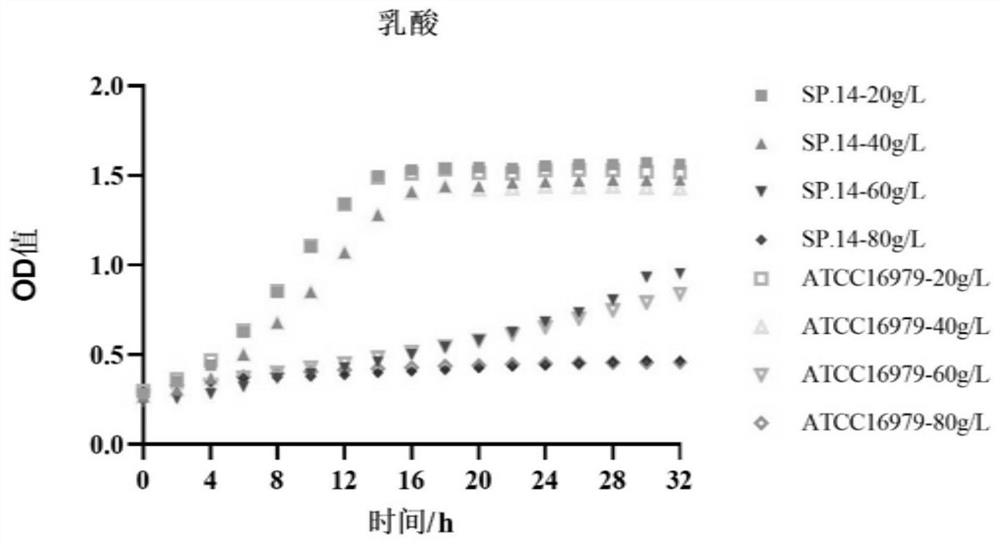Schizosaccharomyces pombe with high acetic acid tolerance
A technology of Schizosaccharomyces pombe and ethanol, applied in the field of microorganisms, can solve problems such as yeast fermentation inhibition, achieve ethanol resistance, good lactic acid resistance, and solve the effect of fermentation inhibition
- Summary
- Abstract
- Description
- Claims
- Application Information
AI Technical Summary
Problems solved by technology
Method used
Image
Examples
Embodiment 1
[0029] Example 1 Molecular biology identification
[0030] 26SrDNA identification of the strain Schizosaccharomyces pombe Sujiu.014. The selected universal primers are:
[0031] NL1 (5'-GCATATCAATAAGCGGAGGAAAAG-3');
[0032] NL4 (5'-GGTCCGTGTTTCAAGACGG-3').
[0033] The length of the amplified fragment is about 600bp. The target fragment was sent to Jinweizhi for sequencing, and the sequencing results were compared with the 26S rDNA sequences registered in GenBank (KY296084.1, MT729825.1, NR_151433.1, CU329672.1, etc.), and the homology reached 98%, see Figure 6 . The strain was identified as Schizosaccharomyces pombe by 26S rDNA sequence analysis.
Embodiment 2
[0034] Example 2 Bacterial colony morphology, microscopic morphology observation
[0035] (1) Colony: the purified single colony was inoculated on WL medium by dilution and plating, cultured at 30°C for 2-3 days, and the colony morphology was observed and recorded. The result is as figure 1 As shown in -a, the colony is hemispherical, with neat edges, opaque, yellowish on the front and back, uniform texture and easy to stir up.
[0036] (2) Microscopic examination: Methylene blue staining, 40X oil microscope observation. The result is as figure 1 As shown in -b, the thallus is rod-shaped without flagella.
[0037] (3) Scanning electron microscope:
[0038] Culture the yeast on a shaker for 16 hours (stable period), take 5mL of the bacterial solution and add it to a 50mL centrifuge tube, centrifuge at 7000r / min for 2min, pour off the supernatant; add 20mL of 5% fixative glutaraldehyde solution, vortex and oscillate and let stand. Fix for 2 hours; add 20mL PBS buffer, wash ...
Embodiment 3
[0039] Embodiment 3 carbon and nitrogen source assimilation experiment
[0040] (1) Carbon source assimilation test
[0041] Assimilative carbon source basal medium: (NH 4 ) 2 SO 4 0.5%, KH 2 PO 4 0.1%, MgSO 4 ·7H 2 O 0.05%, yeast extract powder 0.02%, agar 2%, sterilized at 115°C for 15min.
[0042] The carbon sources tested were citric acid, galactose, xylose, ethanol, lactic acid, acetic acid, and arabinose, and they were sterilized by a filter membrane (0.20 μm) with a sterilized syringe to make the content reach 50 mmol / L.
[0043] Put the tested bacteria into 3mL sterile normal saline, shake well, draw 1mL of yeast suspension into a sterile petri dish, then pour into the carbon-source-free basal medium that has been melted and cooled to about 45-50°C, shake Mix well, and after solidification, place it at 30°C and incubate it upside down for 7 hours. Take out the bacteria-carrying plate, and divide it into six plots with a glass pencil on the bottom of the plate,...
PUM
| Property | Measurement | Unit |
|---|---|---|
| width | aaaaa | aaaaa |
| length | aaaaa | aaaaa |
Abstract
Description
Claims
Application Information
 Login to View More
Login to View More - R&D
- Intellectual Property
- Life Sciences
- Materials
- Tech Scout
- Unparalleled Data Quality
- Higher Quality Content
- 60% Fewer Hallucinations
Browse by: Latest US Patents, China's latest patents, Technical Efficacy Thesaurus, Application Domain, Technology Topic, Popular Technical Reports.
© 2025 PatSnap. All rights reserved.Legal|Privacy policy|Modern Slavery Act Transparency Statement|Sitemap|About US| Contact US: help@patsnap.com



